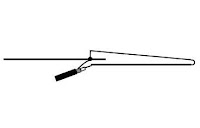Data for the 2-element array was obtained from an old ARRL Handbook.
Dimensions in inches: Driven Element - 5540/f MHz, Director - 5263/f MHz, Spacing - 2750/f MHz.
The spacing close to 0.25λ would result in a good match for 50Ω coaxial cable.
Maximum gain would be possible with a director at 0.1λ or a reflector at 0.15λ. However matching issues related to the very low radiation resistance would then have to be tackled (F.C.Judd G2BCX in '2 meter Antenna Handbook').
 |
| 2m 2-element array |
 |
| 2m 2-element array - close-up (element folded) |
Theoretical gain for this array is 3dB.
Preliminary on-the-air checks for gain, front-to-back ratio and null, were encouraging.
Related post: J-Pole Collinear for 2m
_______________________________











